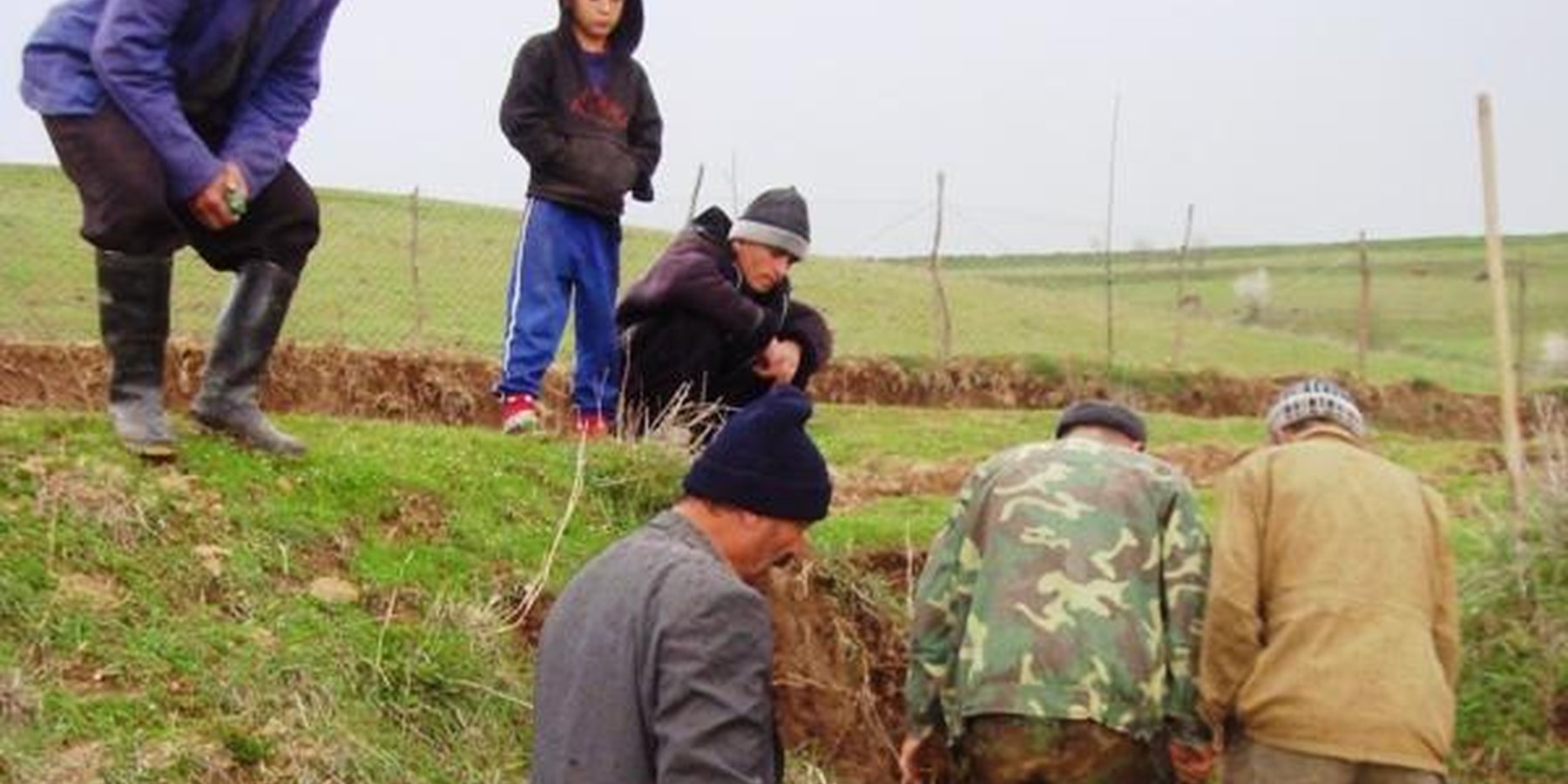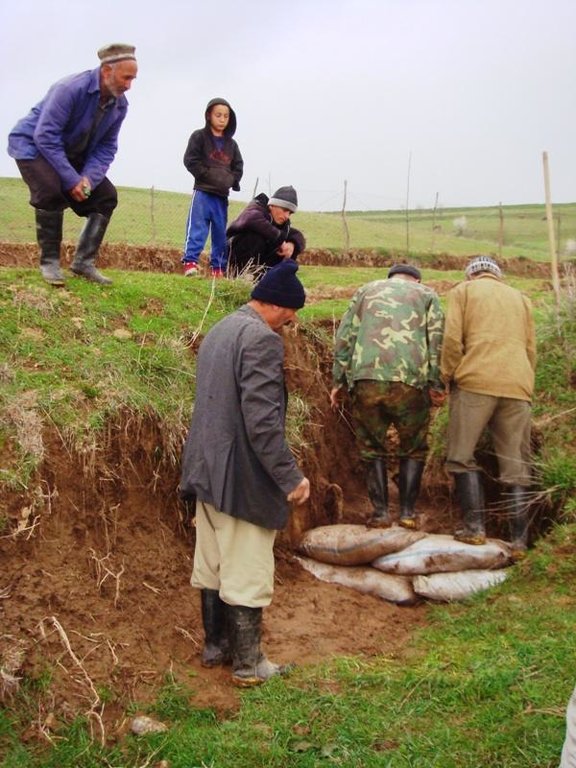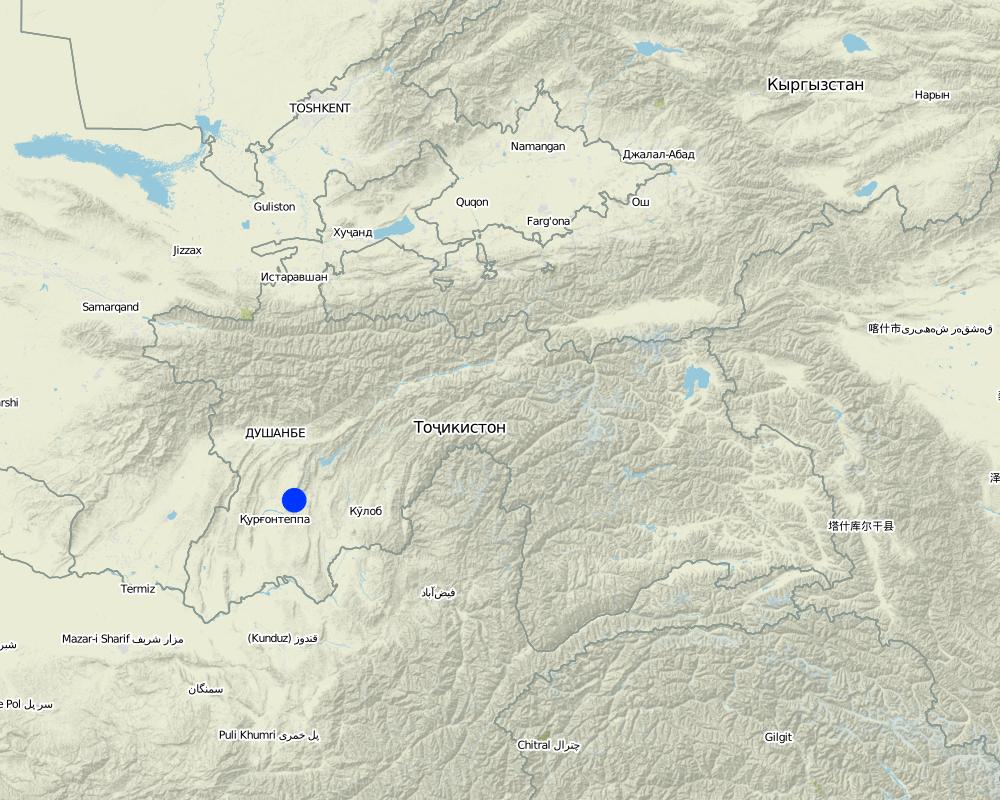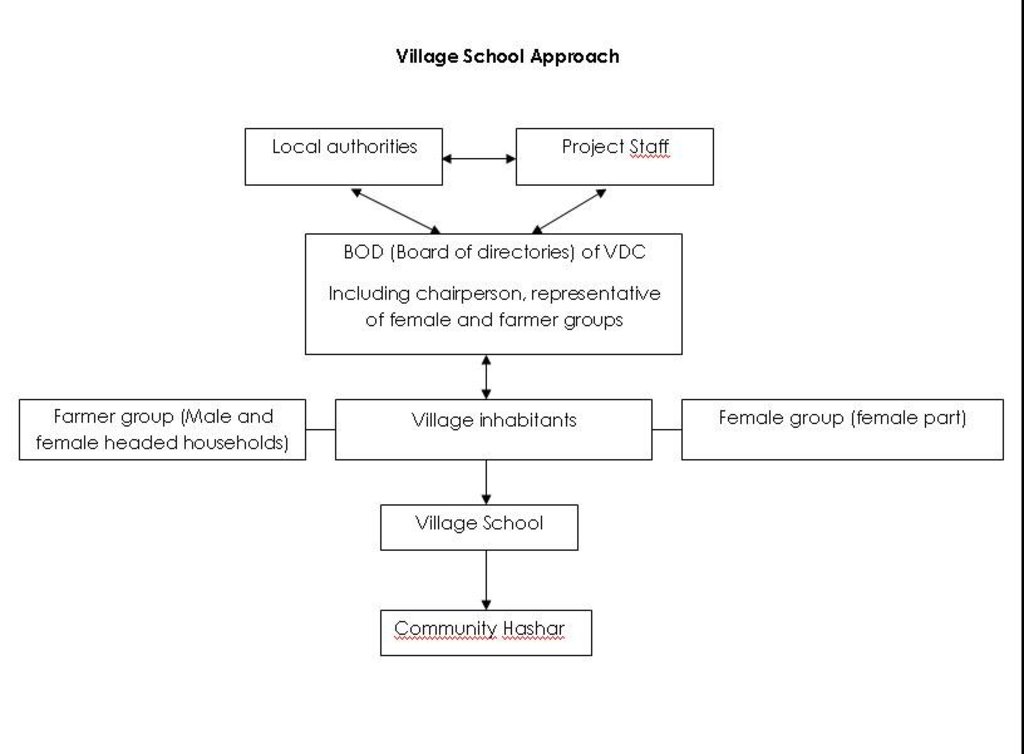Village school participation and involvement [طاجيكستان]
- تاريخ الإنشاء:
- تحديث:
- جامع المعلومات: Daler Domullojonov
- المحرر: –
- المُراجع: David Streiff
Чалб ва иштироки мактаби деха
approaches_2572 - طاجيكستان
عرض الأقسام
توسيع الكل طي الكل1. معلومات عامة
1.2 تفاصيل الاتصال بالأشخاص الرئيسيين لمصدر المعلومات والمؤسسات المعنية بتقييم وتوثيق النهج
اسم المؤسسة (المؤسسات) التي سهلت توثيق/تقييم النهج (إذا كان ذلك على صلة)
Deutsche Welthungerhilfe e. V. (Welthungerhilfe) - طاجيكستان1.3 الشروط المتعلقة باستخدام البيانات الموثقة من خلال WOCAT
يوافق جامع المعلومات والشخص (لاشخاص) الرئيسي لمصدر المعلومات على الشروط المتعلقة باستخدام البيانات الموثقة من خلال WOCAT:
نعم
2. وصف نهج الإدارة المستدامة للأراضي
2.1 وصف موجز للنهج
A competitive tendering process for project grant money to implement identified SLM practices within a community, and on completion of the implementation activities the village school will be assigned ownership and responsibility for the maintenance and sustainability.
2.2 وصف تفصيلي للنهج
وصف تفصيلي للنهج:
Aims / objectives: The objective of the approach is to find a mechanism by which you can involve large sections of the community, allocate land for the communities benefit, provide a mechanism for long term maintenance, and establish a demonstration area for cross site visits and educational training.
Methods: Several methods were employed to implement the approach, these included community and local government workshops, seminars on proposal writing followed by subsequent proposal development in conjunction with local experts and community mobilization. The project staff used the approach to train active community members on suitable land management practices that would benefit identified degraded lands and develop sustainable competitive proposals to be reviewed by a selection panel. The community was encouraged to provide substantial input into the funding of their proposed project if they wanted to be successful. A predetermined condition was set on awarded grants that the degraded land had to be officially allocated to the school for a twenty year period.
Stages of implementation: The INGO Welthungerhilfe announced a competition amongst the local communities in one region to submit project proposals for addressing community environmental problems. The local government were involved from the outset, were encouraged to help suggest communities that should compete. The communities were provided with workshops on how to develop sustainable land management proposals with support from local agronomists. The proposals had to outline the commitment of the community, the area of land to be re-established and how, and finally the level of community contribution towards the project. The terms of the competition dictated that the area of rejuvenated land would be officially signed over to the school for a period of twenty year and the school community would thereby be responsible for the maintenance and upkeep of the land and entitled to invest any profits back into the school, hence indirectly supporting many families in the community. The projects were selected based on a predetermined criterion and the winning projects received part funding in the form of fuel, machinery, fencing etc upto 50% of the final costs. The people were mobilised to implement the project though a community day of action know as a ‘Hashar’ and on completion the school assumed responsibility for the plot of land.
Role of stakeholders: Although the approach is project driven it required buy in from the local authorities, and the heads of collective dehkan farms who dedicate land use right to village schools, however it was the school community that had to be the real driving force to see the proposal developed into a tangible outcome.
2.3 صور عن النهج
2.5 البلد/المنطقة/المواقع التي تم تطبيق النهج فيها
البلد:
طاجيكستان
المنطقة/الولاية/المحافظة:
Tajikistan / Khatlon
مزيد من التفاصيل حول الموقع:
Khovaling / Dorobi
Map
×2.6 تواريخ بدء وإنهاء تنفيذ النهج
أشر إلى سنة البدء:
2
سنة الإنهاء (إذا لم يعد النهج مطبقًا):
2009
2.7 نوع النهج
- قائم على مشروع/برنامج
2.8 الغايات/الأهداف الرئيسية للنهج
The Approach focused mainly on SLM with other activities (Community initiated SWC activities realised with involvement of village school, holistic approach, )
environmental restoration by community involvement. to prevent soil erosion, gulley expansion and land degradation; to convert barren land to agroforestry system. to create capacity of villagers and young generation to protect environment and effective use of locally available natural resources.
The SLM Approach addressed the following problems: Poor land management practices compounded by a lack of knowledge and funds that have resulted in continued land degradation and loss of fertility.
2.9 الظروف التي تمكن أو تعيق تنفيذ التقنية/التقنيات المطبقة بموجب النهج
توفر/الوصول إلى الموارد والخدمات المالية
- معيق
Limited availability of funds
Treatment through the SLM Approach: Project provided support funding to match contributions provided by the community.
الإطار القانوني (حيازة الأراضي، وحقوق استخدام الأراضي والمياه)
- تمكين/تمكيني
The existing land ownership, land use rights / water rights greatly helped the approach implementation: The state were very supportive of the allocation of land to the schools.
- معيق
There were no formal documented land user rights on the land selected for the implementation of technologies.
Treatment through the SLM Approach: Before the implementation started the plot of land was officially assigned to the school for a period of 20 years.
المعرفة حول الإدارة المستدامة للأراضي، والوصول إلى الدعم الفني
- معيق
There is a lack of technical knowledge within the community.
Treatment through the SLM Approach: A series of cross visits and practical trainings were organised by the project to neighboring communities.
عبء العمل، توفر القوى العاملة
- معيق
There is extensive work required in the successful implementation and maintenance of the chosen technologies.
Treatment through the SLM Approach: The plot was divided into 3 parts to assign specific responsibilities.
3. المشاركة وأدوار الأطراف المعنية
3.1 أصحاب المصلحة المعنيون بالنهج وأدوارهم
- مستخدمو الأراضي المحليون/المجتمعات المحلية
Community members and farmers
Mainly heavy activities like organic fertilizers carry, ploughing and planting was carried by males.
Women supported with feeding of workers.
All interested community members were involved in all stages of activities implementation and final beneficiary of action is school.
- متخصصون في الإدارة المستدامة للأراضي / مستشارون زراعيون
The approach was designed by international experts with input from national specialists
Project technical staff, advisor
- المعلمون / أطفال المدارس / الطلاب
School teacher
- منظمة غير حكومية
WHH project staff
- الحكومة المحلية
Head of jamoat (sub district), and village head
إذا كان هناك العديد من الأطراف المعنية، قم بالإشارة إلى الوكالة الرائدة:
local authorities and project staff
3.2 انخراط مستخدمي الأراضي المحليين/المجتمعات المحلية في المراحل المختلفة للنهج
| انخراط مستخدمي الأراضي المحليين/المجتمعات المحلية | حدد من شارك وصف الأنشطة | |
|---|---|---|
| المبادرة/التحفيز | التعبئة الذاتية | community members leading by teacher presented project proposal to receive support of project realization to WHH project |
| التخطيط | تفاعلي | teachers together with project staff look through and updated plan |
| التنفيذ | تفاعلي | in the beginning it was really good and active labor and in-kind contribution of activity, once additionally in cash contribution was required teacher continued alone |
| الرصد/التقييم | الدعم الخارجي | joint (project staff and villagers) monitoring of activities were realized during activities implementation and finalizing |
| Research | غير موجود |
3.3 مخطط التدفق (إذا كان متاحًا)
الوصف:
The organisational set up instigated by the project staff with the involvement of the local authorities resulting in a community day of action for implementation of the technologies
المؤلف:
Daler Domullojonov (WHH, Dushanbe)
3.4 اتخاذ القرار بشأن اختيار تقنية/تقنيات الإدارة المستدامة للأراضي
حدد من الذي قرر اختيار التقنية/التقنيات التي سيتم تنفيذها:
- متخصصون في الإدارة المستدامة للأراضي بشكل أساسي، بعد التشاور مع مستخدمي الأراضي
اشرح:
The idea was discussed in meeting with villagers, local authorities representatives and project staff.
Decisions on the method of implementing the SLM Technology were made by mainly by SLM specialists with consultation of land users. In the joint meetings low cost measures were chosen and cost sharing discussed with the community members.
4. الدعم الفني وبناء القدرات وإدارة المعرفة
4.1 بناء القدرات/التدريب
هل تم تقديم التدريب لمستخدمي الأراضي / الأطراف المعنيين الآخرين؟:
نعم
حدد من تم تدريبه:
- مستخدمو الأراضي
- موظفون ميدانيون/ مستشارون
إذا كان ذلك على صلة، حدد الجنس والعمر والوضع والعرق وما إلى ذلك.
To approach provided training on proposal writing and during the technology implementation stage on basic soil c conservation techniques.
شكل التدريب:
- في العمل
- من مزارع إلى مزارع
- مناطق العرض
- اجتماعات عامة
المواضيع المغطاة:
Proposal writing, soil conservation techniques and cross site visits.
4.2 خدمة استشارية
هل يملك مستخدمو الأراضي وصولا إلى خدمة استشارية؟:
نعم
حدد ما إذا كانت الخدمة الاستشارية متوفرة:
- في حقول مستخدمي الأراضي
وصف/تعليقات:
Advisory service is quite adequate to ensure the continuation of land conservation activities; heads of jamoat (sub district), collective dehkan farm and village
4.3 تعزيز المؤسسات (التطوير التنظيمي)
هل تم إنشاء أو تعزيز مؤسسات من خلال هذا النهج؟:
- لا
4.4 الرصد والتقييم
هل يشكل الرصد والتقييم جزءا من النهج؟:
نعم
التعليقات:
area treated aspects were regular monitored by project staff through observations; indicators: covered area
no. of land users involved aspects were ad hoc monitored by land users through observations; indicators: progress of used technics
technical aspects were regular monitored by land users through observations; indicators: None
management of Approach aspects were ad hoc monitored by project staff through observations; indicators: None
There were no changes in the Approach as a result of monitoring and evaluation: None
There were few changes in the Technology as a result of monitoring and evaluation: Check dams with plastic sacks were covered after observing short durability, The size of contour trenches were adjusted after rainy season, additionally to rain water harvesting pounds establishment of conservation pound was added upstream
4.5 البحوث
هل كانت البحوث جزءًا من النهج؟:
نعم
حدد المواضيع:
- تكنولوجيا
أعط تفاصيل إضافية وأشر إلى من قام بالبحوث:
Research was carried out on-farm
5. التمويل والدعم المادي الخارجي
5.1 الميزانية السنوية لمكون الإدارة المستدامة للأراضي في النهج المذكور
إذا لم تكن الميزانية السنوية الدقيقة معروفة، قم بالإشارة إلى نطاقها:
- 10,0000-2,000
التعليقات (على سبيل المثال المصادر الرئيسية للتمويل/الجهات المانحة الرئيسية):
Approach costs were met by the following donors: local community / land user(s) (labour, poles for fence, seedlings of trees and shrubs, seeds of grains, rent of tractor ): 60.0%; international non-government (fencing material, fuel for earth works, part of seedlings, seeds of perennial plants): 40.0%
5.2 الدعم المالي/المادي المقدم لمستخدمي الأراضي
هل حصل مستخدمو الأراضي على دعم مالي/ مادي لتنفيذ التقنية/ التقنيات؟:
نعم
إذا كانت الإجابة بنعم، حدد نوع (أنواع) الدعم والشروط والمزودين:
In the implementation EC TACIS financed the Welthungerhilfe project support in form of materials and seeds
5.3 إعانات لمدخلات محددة (بما في ذلك العمالة)
- زراعة
| حدد المدخلات التي تم دعمها | إلى أي مدى | حدد الإعانات |
|---|---|---|
| بذور | ممول جزئيا | |
| أسمدة | ممول جزئيا | |
| seedlings | ممول جزئيا | |
- غير ذلك
| غير ذلك(حدد) | إلى أي مدى | حدد الإعانات |
|---|---|---|
| logistics | intial discussion groups and trainings |
إذا كان العمل من قبل مستخدمي الأراضي مدخلاً جوهريًا، فهل كان:
- تطوعي
التعليقات:
The village organised a HASHAR i.e. a community action day.
The initial discussion and training on the development of proposals was partly financed by the community.
5.4 الائتمان
هل تم توفير ائتمان في إطار نهج أنشطة الإدارة المستدامة للأراضي؟:
كلا
6. تحليل الأثر والتصريحات الختامية
6.1 آثار النهج
هل ساعد النهج مستخدمي الأراضي على تنفيذ وصيانة تقنيات الإدارة المستدامة للأراضي؟:
- لا
- نعم، قليلا
- نعم، باعتدال
- نعم، إلى حد كبير
First of all the approach was discussed with all community members.
هل ساهم النهج في تمكين الفئات المحرومة اجتماعيا واقتصاديا؟:
- لا
- نعم، قليلا
- نعم، باعتدال
- نعم، إلى حد كبير
The project was focused on providing for the communitz schools.
هل أدى النهج إلى تحسن في مسائل حيازة الأراضي / حقوق المستخدمين التي أعاقت تنفيذ تقنيات الإدارة المستدامة للأراضي؟:
- لا
- نعم، قليلا
- نعم، باعتدال
- نعم، إلى حد كبير
The problem is unlikely to be overcome in the near future.
Did other land users / projects adopt the Approach?
- لا
- نعم، قليلا
- نعم، باعتدال
- نعم، إلى حد كبير
The approach was implemented in another 15 communities.
Did the Approach lead to improved livelihoods / human well-being?
- لا
- نعم، قليلا
- نعم، باعتدال
- نعم، إلى حد كبير
It was good example of integration low cost soil and water conservation measures to restore existing problems instead of complaining about lack of funds and extra support.
Did the Approach help to alleviate poverty?
- لا
- نعم، قليلا
- نعم، باعتدال
- نعم، إلى حد كبير
non productive land was converted to agro forest, and for the future a well managed orchard can provide substantial support to the school.
6.2 المحفز الرئيسي لقيام مستخدمي الأراضي بتنفيذ الإدارة المستدامة للأراضي
- زيادة الربح (القدرة)، وتحسين نسبة التكلفة إلى العائد
to convert non profitable land to orchard
- المدفوعات/ الإعانات
to get support for address environmental problem
- الوجاهة والضغط الاجتماعي/التماسك الاجتماعي
can be proud of their achievements among other schools
- well-being and livelihoods improvement
to support school
6.3 استدامة أنشطة النهج
هل يمكن لمستخدمي الأراضي المحافظة على استدامة ما تم تنفيذه من خلال النهج (بدون دعم خارجي)؟:
- غير مؤكد
إذا كان الجواب لا أو غير متأكد، حدد ذلك وعلق عليه:
The approach was project driven and provided subsidises therefore it may be difficult for the communities to replicate without external sources of finance.
6.4 نقاط قوة/مزايا النهج
| نقاط القوة/ المزايا/ الفرص من وجهة نظر مستخدمي الأراضي |
|---|
| Additional income source for school budget. (How to sustain/ enhance this strength: Pupils could be taught how to optimise the use of the land.) |
| Improvement in the quality of land and has reduced the risk from natural disasters. (How to sustain/ enhance this strength: The technologies could be adapted as the land improves in the future.) |
| نقاط القوة/ المزايا/ الفرص من وجهة نظر جامع المعلومات أو غيره من الاشخاص الرئيسيين لمصدر المعلومات |
|---|
| A major problem was to connect the land tenure with the final beneficiaries within the community. This issue was solved through handing over all rights to village school. (How to sustain/ enhance this strength: The approach may benefit from the involvement of legal land specialist.) |
| It is a low cost, holistic, approach involving all community through village school. (How to sustain/ enhance this strength: It could be further enhanced with extra support of local authorities) |
| The approach provides a source of income for the school and provides a place of learning for the children. (How to sustain/ enhance this strength: Further sites with different SLM practices coul dbe developed into school demonstration plots.) |
6.5 نقاط الضعف/ العيوب في المنهج وطرق التغلب عليها
| نقاط الضعف/ المساوىء/ المخاطر من وجهة نظر مستخدم الأراضي | كيف يمكن التغلب عليها؟ |
|---|---|
| It required continuously cultivation activities in the beginning. The community became tired of volunteering after several days. | Responsible person /s has to be in charge to mobilise the people |
| نقاط الضعف/ المساوىء/ المخاطر من وجهة نظر جامع المعلومات أو غيره من الاشخاص الرئيسيين لمصدر المعلومات | كيف يمكن التغلب عليها؟ |
|---|---|
| In the beginning the school did not benefit too much. | Additional crops can be planted |
7. المراجع والروابط
7.1 طرق جمع/مصادر المعلومات
- زيارات ميدانية، مسوحات ميدانية
- مقابلات مع مستخدمي الأراضي
7.2 المراجع للمنشورات المتاحة
العنوان، المؤلف، السنة، النظام القياسي الدولي لترقيم الكتب ISBN:
Final narrative report of EC Contract # 144-912
متاح من أين؟كم التكلفة؟:
Welthungerhilfe project in Temurmalik district
الروابط والوحدات المواضيعية
توسيع الكل طي الكلالروابط
لا يوجد روابط
الوحدات المواضيعية
لا يوجد وحدات مواضيعية





